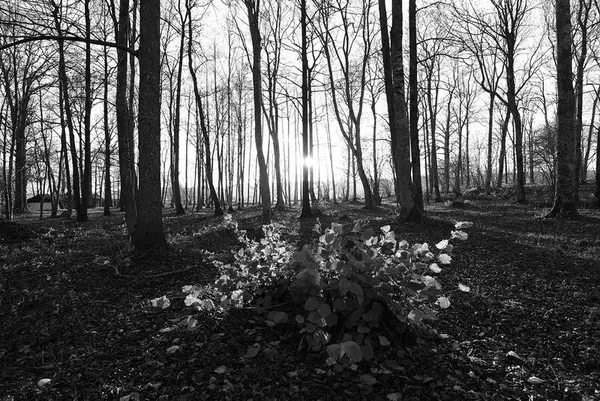- 1/1
© Siggen Stinessen, Borreskogen nr 37, 2015–2019. Preus museum Collection.
They were photographed between 2015 and 2019 by Siggen Stinessen who lives in Horten. His photos provide us with an outlook on two different types of landscape. To the west you can see the tree trunks in front of the large burial mounds and the park. To the east you can see the beach and the sea. The sea is shallow for a long way out and there is a sort of road which runs straight out towards the horizon. The pictures were taken in different types of weather and during different seasons. There is snow and water. The landscape is dry and the sun is shining.
A few photos contain long shadows cast by the photographer. They have an almost predetermined composition. They are symmetrical and often have a tree or mound located in the centre. The horizon splits the photos in two the other way. The area that Stinessen has photographed has both an everyday and a special nature. Borreparken contains burial mounds, the remains of buildings and boats dating back to around 600 to 900 AD.
There are large trees in the park and there is a deciduous, biodiverse forest between the burial mounds and the sea. The area is a recreation park, but it is also the first national park in Norway, which was founded and opened by King Haakon in 1932. The history of the site has a darker side which is linked to Vidkun Quisling and his use of the park. Every Whitsun between 1935 and 1944 he held political rallies there.
Siggen Stinessen belongs to the generation of photographers who started to make their mark in the 1980s and who were interested in more ordinary and often developed landscapes. It is interesting to see Stinessen as a kind of transitional figure to today's photographers who are working with nature. The Borre Forest is actually slightly atypical of his work since we are talking about a landscape of great historical significance. But there is something about the way he has photographed it that makes it different to more traditional landscape photographs.
The burial mounds create a distant, subdued backdrop to his photos. His focus on tree trunks rather than whole trees creates spaces and lines that draw us towards the pictorial surface. Stinessen himself emphasises that his photos are particularly evocative of the architectural space created by the forest.
There is a kind of democratic emphasis on everything in his photos and nothing has more focus than anything else. Despite the fact that he himself has never linked his ideas about nature conservation to his own work, one can still see the series as a type of pondering on and exaltation of the everyday landscape and the forest that are used by the population on a daily basis.
This text has been taken from an essay written for the exhibition catalogue by Christine Hansen, the co-curator of the exhibition.

